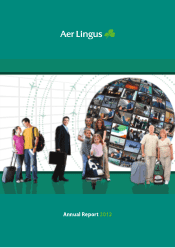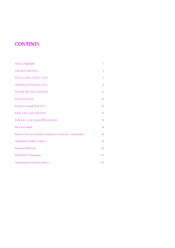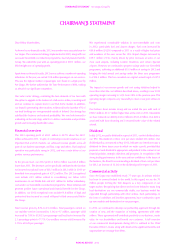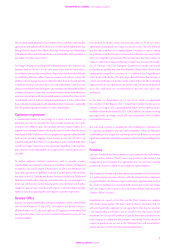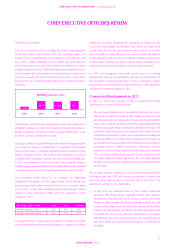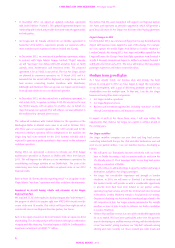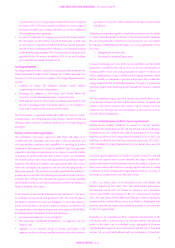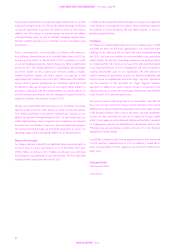Aer Lingus 2012 Annual Report Download - page 11
Download and view the complete annual report
Please find page 11 of the 2012 Aer Lingus annual report below. You can navigate through the pages in the report by either clicking on the pages listed below, or by using the keyword search tool below to find specific information within the annual report.ANNUAL REPORT 2012
9
Our business
Aer Lingus was established in 1936 by the Irish Government to provide air
services between Ireland and the UK. Today, we operate as an independent
airline providing direct passenger and cargo transportation services from
Ireland to the UK, Europe and also to the US.
We are committed to serving airports located at convenient, central
locations which enhance connectivity for our customers. This airport
selection is offered at more competitive prices than most other European
legacy carriers. We further enhance connectivity options to worldwide
destinations through a wide range of airline partners. This diverse range of
partners epitomises our concept of “open network architecture”, whereby
our neutrality allows us to partner across alliances and offer connectivity
through major hubs to worldwide destinations.
Historically, Aer Lingus existed to connect Ireland to the world – and
the world to Ireland. Over the last few years, we have started to widen
the scope of our business to provide an alternative, convenient way for
European passengers to connect to the U.S – and vice versa - for city pairs
with no direct flights. Increasingly, we are looking for opportunities to
apply our business model and cost base in other ways, for example our
“wet lease” agreement with Virgin Atlantic Airways Limited announced in
December 2012 and expanded Aer Lingus Regional franchise model.
Our market
2012 was characterised by challenging macroeconomic conditions and by
weak underlying demand in some of the key markets in which we operate.
In Ireland, our primary market, the economic environment remained
difficult in 2012 from a demand perspective. Full year GDP growth is
expected to be 0.9% (source: Department of Finance Monthly Economic
Bulletin - February 2013) and the unemployment rate in Ireland remained
high in the year at 14.8% (source: CSO). The Irish air travel market is largely
dominated by non-business, leisure travellers and therefore continues to be
adversely impacted by changes in the level of disposable income available.
However, the principal Irish airports (Dublin, Cork and Shannon), recorded
an overall 0.4% increase in passenger numbers in 2012 with Dublin Airport
recording an increase of 1.9% in passenger traffic year-on-year (source:
anna aero). The economic environment in the UK for 2012, which is
another key market for the Group, is forecast to have been weaker than
that in Ireland with zero % GDP growth expected for the year (source: HM
Treasury, January 2013).
In Europe, policy actions taken by the European Central Bank partially
eased concerns about the ability of the European Union to mitigate risks
related to sovereign debt default and the future of the euro currency. In
spite of these actions, concerns remain with regard to eurozone financial
stability, the long term viability of the euro and economic growth across the
region as a whole.
Oil prices stabilised in the second half of 2012 following the dramatic
increase between 2009 and 2011. As a result of the increase in jet fuel
prices and a relative strengthening of the US$ against the euro in 2012, our
fuel bill in 2012 was €26.9 million, or 8.1%, higher than in 2009 in spite
of capacity deployment (measured by ASKs) in 2012 being 12.0% below
capacity deployed in 2009. Inflationary pressure also manifested itself in
airport charges with London Heathrow and Spanish airport authorities in
particular significantly increasing passenger taxes and fees in 2012.
The outlook for the Irish and UK economies remains uncertain in 2013,
with GDP growth projected to remain in low single digit figures. In Ireland,
the impact of austerity measures and tax increases required under the EU/
IMF financial assistance programme will continue to constrain personal
finances and therefore continue to weaken domestic demand for leisure
travel. Similar forces are likely to apply in some of our other key markets
in 2013 which may constrain opportunities for yield growth, particularly
on short haul services. In December 2012, the International Air Transport
Association (“IATA”) released an updated financial forecast for 2013
showing that worldwide commercial airlines net profits are expected to
increase to US$8.4 billion from US$6.7 billion in 2012. However, IATA
expects European airline industry profits to be flat in 2012 and 2013 with
the growth in profitability coming from Asia Pacific and North and Latin
America regions.
Key performance highlights
An analysis of the key performance priorities we set for 2012 in the prior
year, the progress we achieved in 2012 on those targets and our 2013
priorities are as follows:
Continued emphasis on demand led network management
2012 priority: Continue to pursue the disciplined approach of recent years
to the ongoing design of the Aer Lingus route portfolio in order to maximise
revenue per seat as a key determinant of profitability, while recognising
that there are unsold seats on many of our flights offering an opportunity to
improve profitability by improving load factor.
Progress achieved in 2012 and relevant performance indicators: We
maintained our disciplined approach to capacity deployment with overall
capacity increasing by just 0.5% compared to 2011. Short haul capacity,
as measured by ASKs, decreased by 0.4% whereas long haul capacity
increased by 2.3%. Through fleet and network scheduling adjustments
and an emphasis on marketing to inbound and transfer passengers on
short haul, and with increased demand on long haul, passenger numbers
increased year-on-year resulting in a positive performance with respect to
RPKs and load factor.
OPERATING REVIEW AND KEY PERFORMANCE HIGHLIGHTS Aer Lingus Group Plc
OPERATING REVIEW AND KEY PERFORMANCE HIGHLIGHTS

